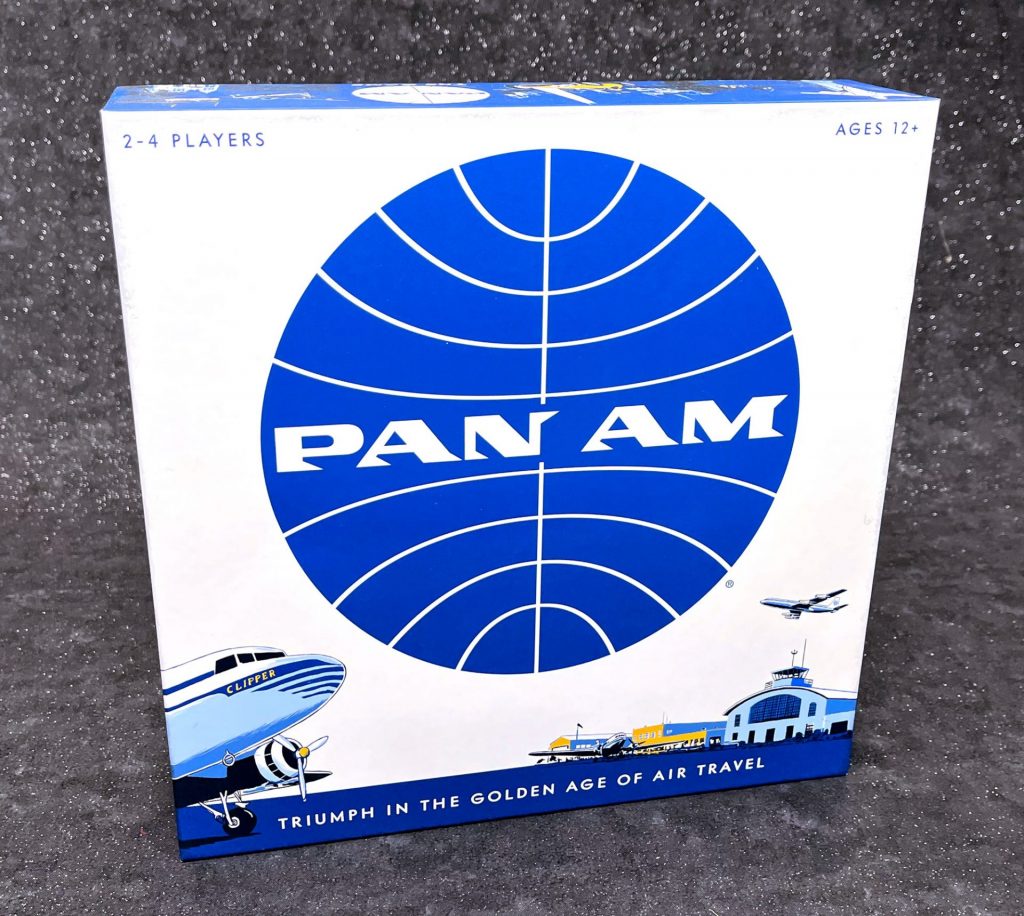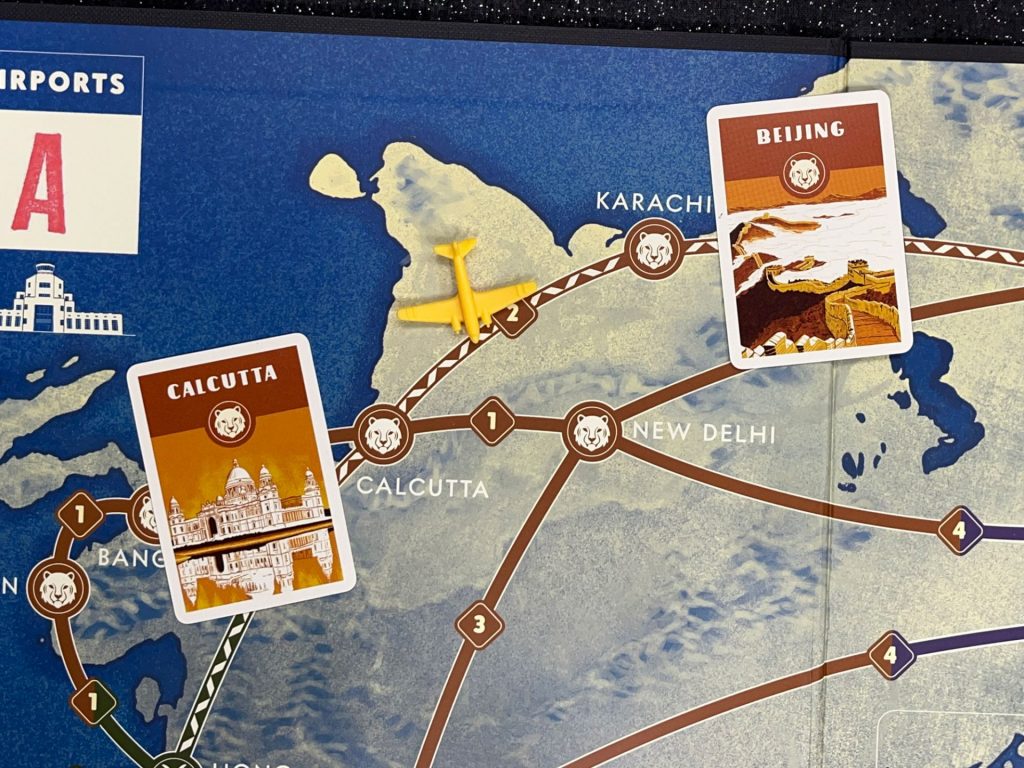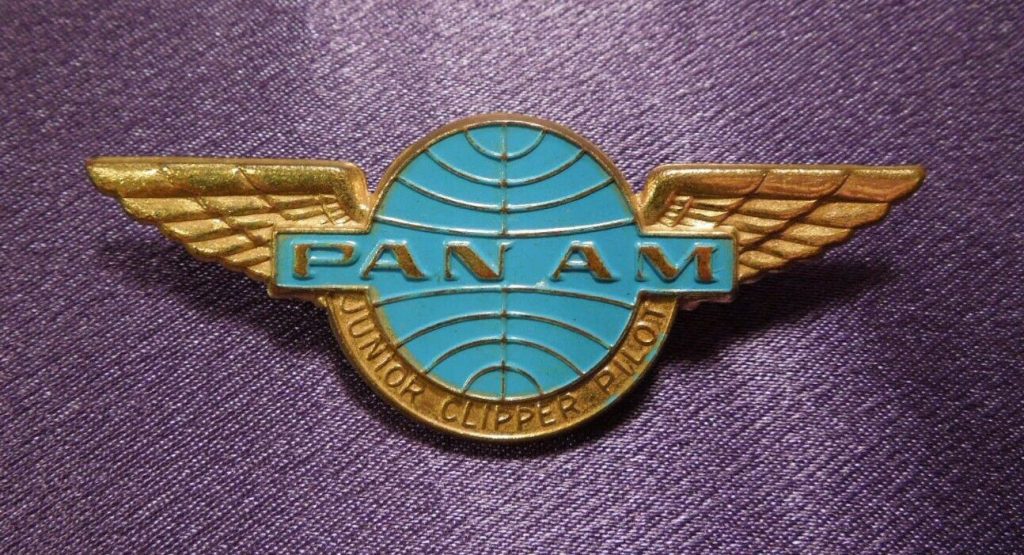Founded in 1927 Pan American Airways, commonly known as Pan Am (or Pan American World Airways), was a pioneer in passenger aviation for most of the 20th century. It revolutionized the industry by becoming the first airline to fly worldwide, and brought about innovations such as computerized reservation systems and jet aircraft. During its 70 year lifespan Pan Am represented glamour, luxury, and status, and helped shape the standard by which all other airlines measured hospitality and customer service.
But Pan Am the board game? That’s crazy talk right?
Pan Am Overview
In 2020, Funko Games released Pan Am, a board game set during the golden age of air travel, when Pan American Airways was on a growth curve that looked like the takeoff trajectory of one of its passenger flights. In Pan Am players each represent a small airline struggling to get off the ground. Over the course of 7 rounds you’ll use your engineers to purchase aircraft, acquire airports, and compete for Landing Rights in cities in North and South America, Asia, and Europe. All the while you’ll be watching Pan Am expand into your territory: slowly but surely taking over everything you’ve worked for (the game is called Pan Am after all). At the end of the game, the player with the most Pan Am stock will be declared the winner.

The Board
Pan Am is a worker placement game whose board has five main areas, each designated with a letter: Airports (A), Destinations (B), Hangars (C), Routes (D), and Directives (E). The Airport, Destinations, and Hangars areas each have a bidding track which dictates the cost of taking that action (Destinations and Hangars have multiple bidding tracks). Players place their workers on the space of their choice, but may be outbid should another player elect to spend more. The outbid player gets their worker back and may use it on a future turn, even bidding on the same space they were ousted from. Only a single worker may occupy the tracks in Airports, Destinations, and Hangars. The Routes and Directives tracks do not have an associated cost, and allow multiple workers.

The Anatomy of a Round
Each turn in Pan Am is composed of 4 phases, starting with the Event phase. Before the game starts players will randomly select 1 card from each of the 7 round decks (representing the 7 decades that Pan Am was in business). At the beginning of each round the top Event card is revealed and affects players in some way. The Event card also dictates the rise or fall of Pan Am’s stock price, and how the company will will expand at the end of the round (more on that later).

In the Engineer phase players will send their workers out to the various areas of the board to accomplish the tasks needed to run an airline. Once all worker locations are finalized, play moves into the Resolution phase (executed in alphabetical order) in which players retrieve their workers (paying any associated costs) and perform that action.
- Airports – Airports allow you to place an airport tower in any city on the board, gaining permanent Landing Rights. This action increases your income by 1.
- Destinations – Destination cards provide Landing Rights in various cities around the board by matching the displayed city or its region.
- Hangars – Hangars allow you to add aircraft to your fleet. You must have aircraft in order to complete a Route.
- Routes – Once you have Landing Rights in a pair of cities, and an aircraft, you’ll need the Route action in order to claim a route. Each route has a value from 1 to 4. This action increases your income by the value of the route.
- Directives – The Directives space provides 2 things to the player: at the beginning of the following round that player will be able to place their worker before the first player takes their first action. Additionally this space provides a Directive card.
- Directive cards are a mixed bag of game changing cards: free stock at the end of the game, the ability to sell routes to Pan Am whenever you like, getting a Destination card for free, etc. Directive cards display red text which dictate when that card can be played. Players begin the game with 1 Directive card, kept hidden from the other players.

During the Resolution phase players retrieve their workers and perform the associated actions as described above. One thing to note: if you must pay for an action and you don’t have the money you’ll be required to pay what money you have, then sell any Pan Am stock you have at a loss to make up the remainder.
Since there are 7 rounds in the game, and only one player may place an Airport tower each round, there will be a maximum of 7 Airport towers placed on the board via the Airport action (some Directive cards can also allow players to place Airport towers). You can’t underestimate the usefulness and importance of this action.
Since the tower gives you permanent Landing Rights to the city where your tower resides, it’s extremely powerful. Which brings us to a discussion of arguably the most complex part of the game.
Landing Rights
 Claiming routes on the game board is central to a victory in Pan Am. Not only do they provide income over the course of the game, but routes also have the potential to be bought out as Pan Am grows along the three expansion routes. Understanding how Landing Rights works is critical to your success in the game.
Claiming routes on the game board is central to a victory in Pan Am. Not only do they provide income over the course of the game, but routes also have the potential to be bought out as Pan Am grows along the three expansion routes. Understanding how Landing Rights works is critical to your success in the game.
Before we go any further, let me offer a quick note about Destination cards. They come in 5 different colors, representing the Asian, European, Pacific, North American, and South American regions on the board. Each card has a city, color, and icon (which matches the color). When Destination cards are claimed they are placed face up in front of you.
To claim a route, you must have Landing Rights to both cities on either side of the route marker, which can be achieved in one of 4 ways.
- If you have placed an airport in one of the cities.
- If you have the Destination card of one of the cities in front of you. Note that this card is not discarded.
- If you discard a Destination card matching the region of one of the cities.
- If you discard a pair of Destination cards of the same region that do not match the desired region.
Here’s a few examples for clarity.
The player wishes to claim the San Francisco to Honolulu route. They have an airport in San Francisco and the Honolulu Destination card. Note that the Honolulu Destination card is not discarded.

The player wishes to claim the Calcutta to Karachi route. They have a Calcutta card and they discard a Beijing Destination card (matching the region of Karachi).

The player wishes to claim the Beijing to Paris route. They discard Rome (matching the region of Paris) and discard the Rio de Janeiro and Lima cards (a pair that do not match the region of the city, Beijing).

Ending the Round
After all workers have been returned to the players, the Pan AM phase is completed. Roll the Pan Am die to determine which way Pan Am will expand, outwards from Miami. The Event card will dictate how many times this die is rolled (between 1-3 times). A route occupied by a player will be bought for the amount listed in the Route Bonus chart on the left side of the board, determined by the length of the route. When routes are sold, the player loses that amount of income, and returns the plane to their personal player board for use on a future turn.
Players then receive money based on their current income, and may buy as much Pan Am stock as they wish based on the current value of the Pan Am stock (tracked in the bottom left corner of the board).

If players just finished Round 7, the player with the most Pan Am stock is the winner.
Final Thoughts
I was born in the 70s, and actually flew Pan Am several times as a child. We lived in Hawaii and traveled back and forth between Oahu and the mainland. I was pretty young so the only things I really remembered were getting to go up to the cockpit and get a “Junior Clipper” pin, and being given a thin woolen blanket with the Pan Am logo on it to cover me while I slept.

But regardless of my fond youthful memories, I was still baffled by the release of a game about an airline that went bankrupt in 1991. That is until I played it. And now that I’ve done research on this topic for the review I also have a better idea of why Funko chose this company as the subject of their first strategy game. Pan Am single-handedly revolutionized the passenger airline industry over a SEVENTY YEAR history – there aren’t many companies that can last a generation, much less almost 4 of them. Pan Am was the first airline to use jets, computer ticketing, and to offer worldwide flights, all of which resulted in a period that is still referred to as “the golden age of air travel”.
Artwork & Components
The first thing you’ll notice about Pan Am is the retro art. “Retro” is a term that gets tossed around quite a bit, but in this case it really is accurate. The rulebook, board, and components are replete with usage of old logos, fonts, and illustrations, along with the travel poster look of the Destination cards. In fact I wouldn’t be surprised if the cover of the rulebook displayed an actual scan of some long-ago designed Pan Am marketing piece – the lovely yellow-blue gradient fuzzy with age and noise. The artwork remains true to the theme through and through.
The components are well executed, if a bit plain, and they work as intended. A fun little side note: the base of the worker pawns fits perfectly on each of the spaces on the various bidding tracks. Yes I know that’s easy enough to accomplish, but it’s very satisfying when placing your worker to make sure it lines up exactly in the space. The cards are decent quality, especially since they don’t really get handled very often. You draw them then put them on the table in front of you.
The symbols and colors are well chosen and from my non-colorblind perspective easy to tell apart. Funko’s design arm, Prospero Hall, does a great job with their designs in general so I’m sure they took the time to do colorblind analysis on the colors. Another nice little nod to accessibility is that each of the planes have little ridges on the wings to help players with visual impairments tell them apart.

Gameplay
The packaging is great, but the gameplay is where Pan Am shines. The designers did a great job merging a number of different mechanisms into one cohesive game. Let’s start with the worker placement aspect. Depending on your player count, you might begin with 5 in a two player game, or only 3 in a 4 player game. And you never earn more. That means in a four player game you only have 21 actions. That’s not as tight as some other games, but because of the way routes work you absolutely must get the Destination, Hangar, and Route actions at some point to be able to accomplish your goals.
The decision to go for the lowest space in the track in hopes of paying less is an optimistic but oftimes naive move. Thankfully, if you get outbid you get your worker back. But that means you’ll be forced to pay $7 for an Airport instead of $5. In many cases it’s better to start your bid at $5 to make other players really think hard about outbidding you. But since money is also public knowledge you can sometimes bid the minimum amount in confidence knowing that other players simply can’t afford to outbid you.
Pan Am is also a game that rewards multiple playthroughs. If you know that placing Routes is critically important in mid-game you might be able to score an airport for less than the cost of a Destination card. That not only increases your income, but also gives you Landing Rights to a city of your choice. Taking an early chance on Directive cards means you’ll not only get to place first in the following round, but could get a powerful ability—for example being able to upgrade one of your airplanes one level. That could mean you get access to a jumbo jet (which isn’t available until round 6) several rounds earlier than the other players. This saves you money and also helps you avoid having to bid for position in the last 2 rounds when only TWO players will get their jet.
But it really all comes down to money in this game. Being able to buy stock from the get go means that you’ll have a better chance of winning the game. Being smart with your money, selling routes to Pan Am when you can, and buying stock low, will give you an edge. Since buying stock is a public action, and players must announce their purchase, you can keep a mental tally. As long as you’re keeping up with Natalie and Dylan you might have a chance. But that doesn’t take into account the hidden Directive cards. In my most recent game I was lucky enough to draw 3 cards which each gave me a free stock at the end of the game, but even that wasn’t enough to give me the win.
I look forward to each play of Pan Am. It’s just the right weight for me. Right around an hour, not too complex, great to look at, and almost always ends in a close game. Is Pan Am the right game for everyone? Probably not, but I love it, and I’m always willing to play it. You should give it a chance as well!











Add Comment